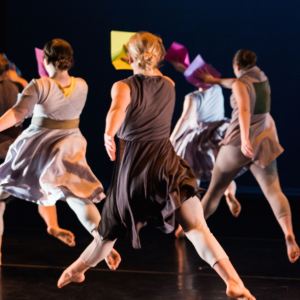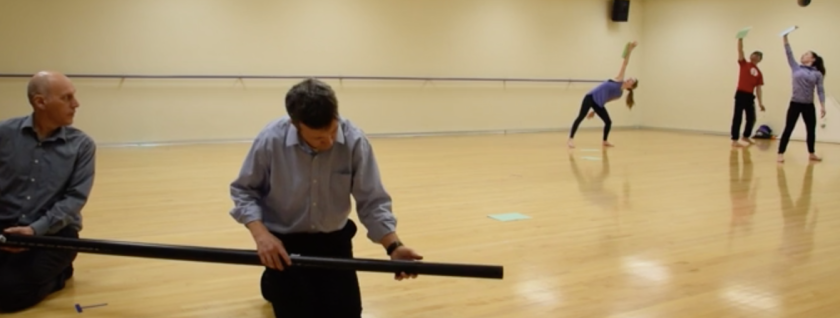Last week saw the official premier of Body in Motion that has been in the works for the past year. Buses carrying a thousand elementary students paraded up to the curb of Weber State’s Browning Center, spilling a flood of children into Austad Auditorium. The following day, five hundred middle and high school students attended as well. The large stage, expansive room, and (especially) the enthusiastic audience were all what this performance was created for, so it was exciting to get to present this invention that we’d been preparing for so long.
After each performance, we took questions from the audience. There were lots of the usual good questions: how much practice, what do the dancers study, how did we think of this or that, etc. But the question that struck us this time was:
 “What is the paper supposed to mean?”
“What is the paper supposed to mean?”
In typical fashion, Erik turned the question back to the student. “What do you think it means?” She told us not what we were expecting or what we were ready for, but what is definitely a beautiful answer:
“I think the paper represents ideas.”
Erik and I both stopped short. That’s the answer we hadn’t thought of; and of course it was a great way to encapsulate what we’d been doing for months. (To get a feel for this if you haven’t seen the performances, you might take a look at our Paper prompt, including a short video clip.) So much of the work that’s gone into creating the pieces, the performance, and the entire program of school visits remind us that this is all about ideas. We need to float the ideas — especially the wrong ones — to figure out what’s going to work best. They are tenuous, difficult to hold onto. They get blown away. They are both precious and unpredictable. They’re influenced by everything around. They’re fun to play with.
More important, the sheets of paper we used in the piece, like ideas, were put onto the stage and put to use in a variety of forms. We can choose what we’d like to do with them, how we’d like to act on them. This reminded us of our handout that we gave to teachers after the performance. At the top it says clearly, “This is not a piece of paper.” Sure, it is a piece of paper, but it isn’t just this. It’s a dance prop and a science experiment, with an infinite number of possibilities just waiting to be tried.
You can download your own copy, either the one-side version with just the print of the “Not a Piece of Paper” text, or a two-side version that includes our performance poster that promotes our public performance this week at Orchesis. (Tickets are available at WeberStateTickets.com.)




 “What is the
“What is the